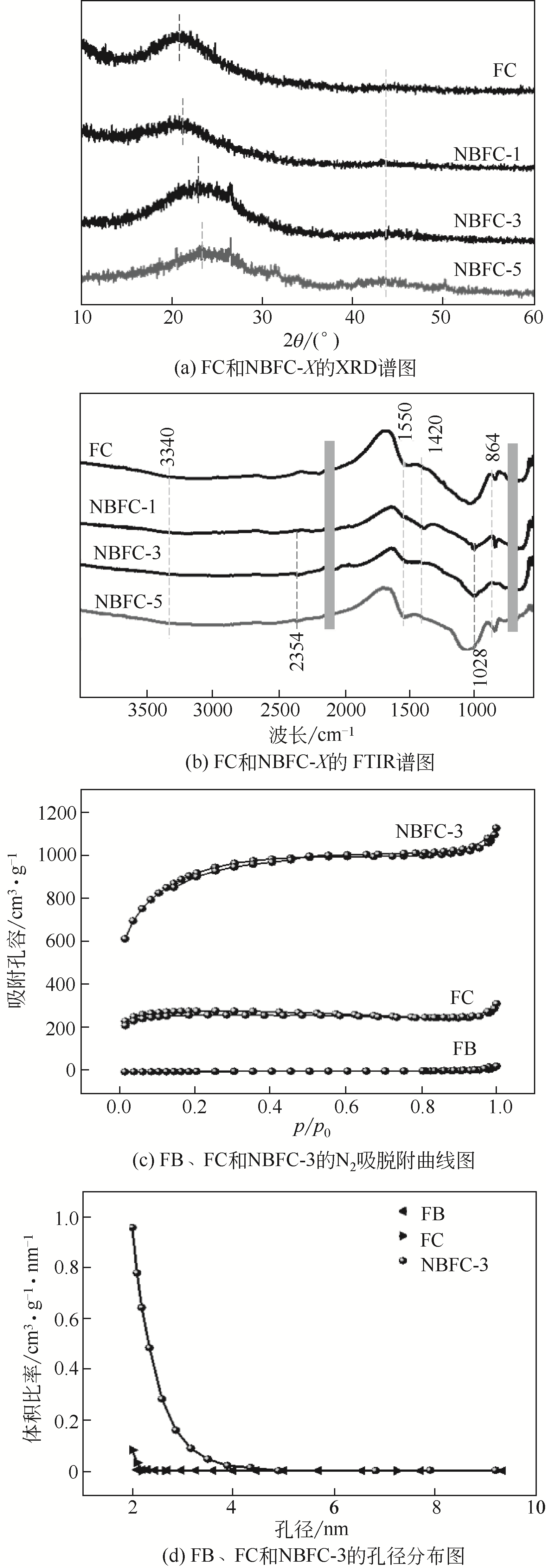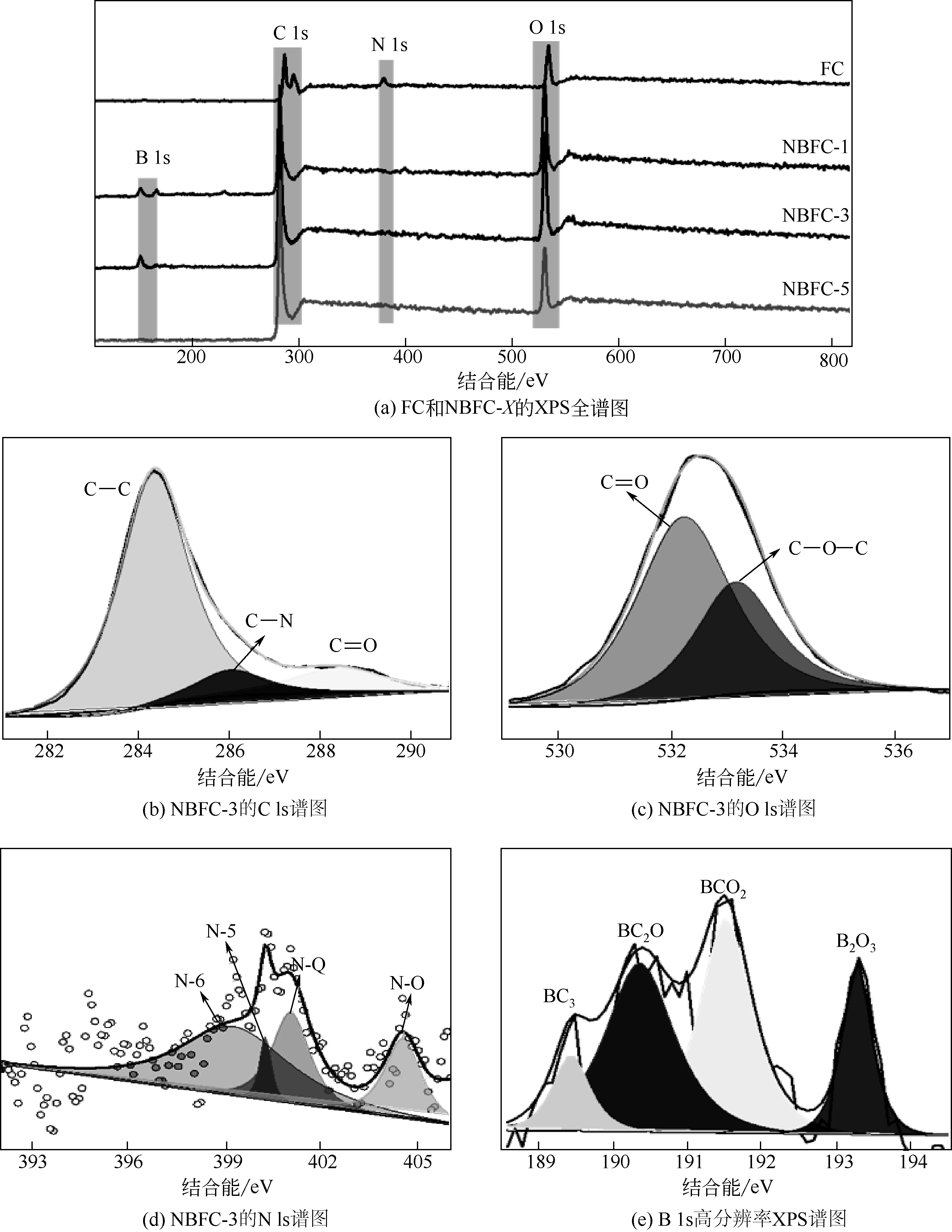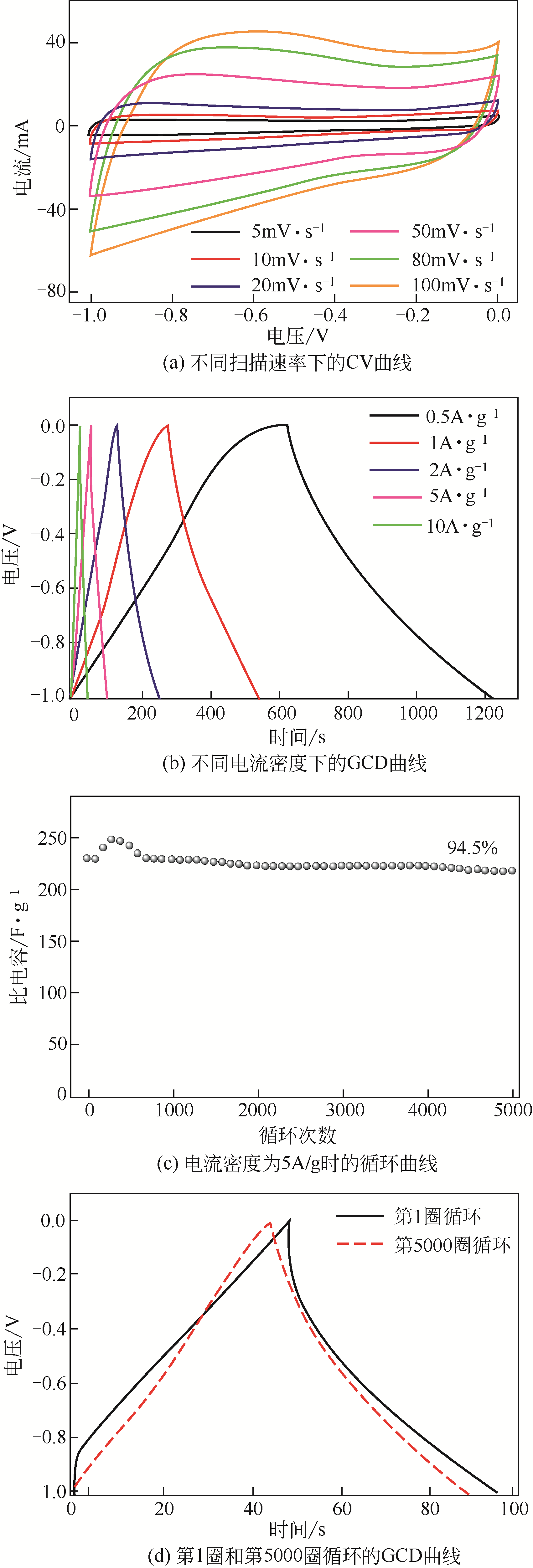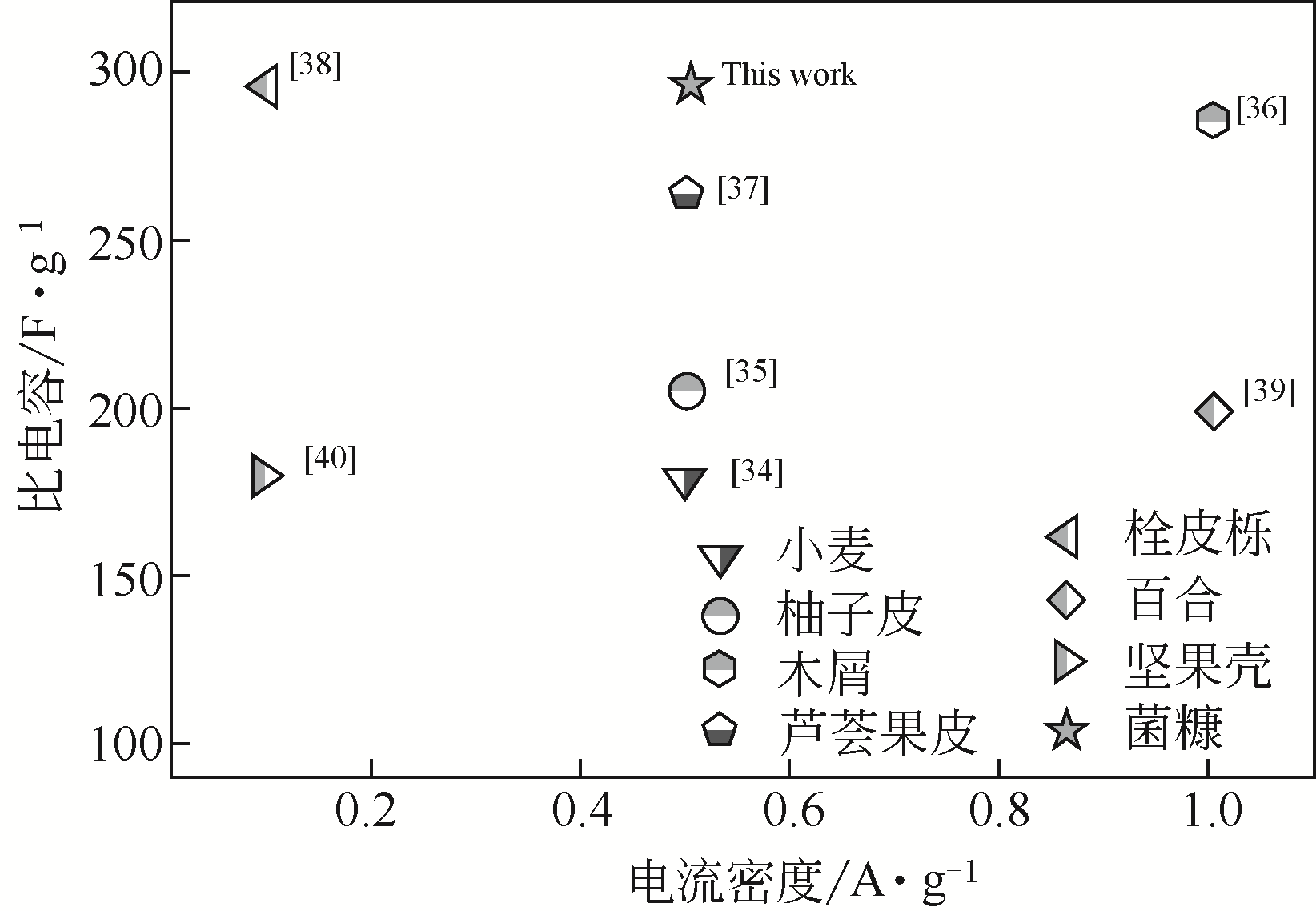Chemical Industry and Engineering Progress ›› 2021, Vol. 40 ›› Issue (3): 1527-1536.DOI: 10.16085/j.issn.1000-6613.2020-0804
• Materials science and technology • Previous Articles Next Articles
N, B-doped carbon from fungus bran: honeycomb structure as electrode material
QU Keqi( ), YOU Yue, SUN Zhe, HUANG Zhanhua(
), YOU Yue, SUN Zhe, HUANG Zhanhua( )
)
- College of Material Science and Engineering, Key Laboratory of Bio-based Material Science and Technology, Ministry of Education, Northeast Forestry University, Harbin 150040, Heilongjiang, China
-
Received:2020-05-12Online:2021-03-17Published:2021-03-05 -
Contact:HUANG Zhanhua
氮硼掺杂菌糠炭:蜂窝结构用于电极材料
- 东北林业大学材料科学与工程学院,生物质材料科学与技术教育部重点实验室,黑龙江 哈尔滨 150040
-
通讯作者:黄占华 -
作者简介:曲可琪(1997—),女,博士研究生,研究方向为生物质炭材料的应用。E-mail:qukeqi1997@163.com 。 -
基金资助:国家自然科学基金(31670592);黑龙江省杰出青年基金(JQ2019C001);中央高校基本科研项目(2572020DX01)
CLC Number:
Cite this article
QU Keqi, YOU Yue, SUN Zhe, HUANG Zhanhua. N, B-doped carbon from fungus bran: honeycomb structure as electrode material[J]. Chemical Industry and Engineering Progress, 2021, 40(3): 1527-1536.
曲可琪, 尤月, 孙哲, 黄占华. 氮硼掺杂菌糠炭:蜂窝结构用于电极材料[J]. 化工进展, 2021, 40(3): 1527-1536.
share this article
Add to citation manager EndNote|Ris|BibTeX
URL: https://hgjz.cip.com.cn/EN/10.16085/j.issn.1000-6613.2020-0804
| 样品 | SBET①/m2·g-1 | V1②/cm3·?g-1 | V2③/cm3·g-1 |
|---|---|---|---|
| FB | 10.41 | 0.001 | 0.02 |
| FC | 849.16 | 0.38 | 0.42 |
| NBFC-3 | 2968.48 | 0.55 | 1.64 |
| 样品 | SBET①/m2·g-1 | V1②/cm3·?g-1 | V2③/cm3·g-1 |
|---|---|---|---|
| FB | 10.41 | 0.001 | 0.02 |
| FC | 849.16 | 0.38 | 0.42 |
| NBFC-3 | 2968.48 | 0.55 | 1.64 |
| 样品 | C | O | N | B |
|---|---|---|---|---|
| FB | 71.46 | 24.68 | 3.86 | 0 |
| FC | 73.58 | 24.21 | 2.21 | 0 |
| NBFC-3 | 77.90 | 17.30 | 1.46 | 3.34 |
| 样品 | C | O | N | B |
|---|---|---|---|---|
| FB | 71.46 | 24.68 | 3.86 | 0 |
| FC | 73.58 | 24.21 | 2.21 | 0 |
| NBFC-3 | 77.90 | 17.30 | 1.46 | 3.34 |
| 1 | LIANG C, WANG Z. Eggplant-derived SiC aerogels with high-performance electromagnetic wave absorption and thermal insulation properties[J]. Chemical Engineering Journal, 2019, 373: 598-605. |
| 2 | 王欢, 杨东杰, 钱勇, 等. 木质素基功能材料的制备与应用研究进展[J]. 化工进展, 2019, 38(1): 434-448. |
| WANG Huan, YANG Dongjie, QIAN Yong, et al. Recent progress in the preparation and application of lignin-based functional materials[J]. Chemical Industry and Engineering Progress, 2019, 38(1): 434-448. | |
| 3 | FU G, LI Q, YE J, et al. Hierarchical porous carbon with high nitrogen content derived from plant waste (pomelo peel) for supercapacitor[J]. Journal of Materials Science: Materials in Electronics, 2018, 29(9): 7707-7717. |
| 4 | 韩尊强, 邢健雄, 余晓娟, 等. 竹炭及其复合材料在超级电容器中的应用研究进展[J]. 林产化学与工业, 2020, 40(1): 8-16. |
| HAN Zunqiang, XING Jianxiong, YU Xiaojuan, et al. Research progress on bamboo-based supercapacitor electrode material[J]. Chemistry and Industry of Forest Products, 2020, 40(1): 8-16. | |
| 5 | WANG J, ZHANG P, LIU L, et al. Controllable synthesis of bifunctional porous carbon for efficient gas-mixture separation and high-performance supercapacitor[J]. Chemical Engineering Journal, 2018, 348: 57-66. |
| 6 | GUO D, XIN R, WANG Y, et al. N-doped carbons with hierarchically micro- and mesoporous structure derived from sawdust for high performance supercapacitors[J]. Microporous and Mesoporous Materials, 2019, 279: 323-333. |
| 7 | YAGLIKCI S, GOKCE Y, YAGMUR E, et al. The performance of sulphur doped activated carbon supercapacitors prepared from waste tea[J]. Environmental Technology, 2020, 41(1): 36-48. |
| 8 | 李诗杰, 郭常敏, 陈学聪, 等. 基于“蛋盒”结构高电化学性能活性炭的制备[J]. 化工进展, 2020, 39(7): 2698-2705. |
| LI Shijie, GUO Changmin, CHEN Xuecong, et al. Preparation of high performance activated carbon based on “egg-box” structure[J]. Chemical Industry and Engineering Progress, 2020, 39(7): 2698-2705. | |
| 9 | ZHAO C, HUANG Y, ZHAO C, et al. Rose-derived 3D carbon nanosheets for high cyclability and extended voltage supercapacitors[J]. Electrochimica Acta, 2018, 291: 287-296. |
| 10 | WANG Y, YANG B, ZHANG D, et al. Strong polar nonaqueous solvent-assisted microwave fabrication of N and P co-doped microporous carbon for high-performance supercapacitor[J]. Applied Surface Science, 2020, 512: 145711-145720. |
| 11 | LOU Z, SUN Y, BIAN S, et al. Nutrient conservation during spent mushroom compost application using spent mushroom substrate derived biochar[J]. Chemosphere, 2017, 169: 23-31. |
| 12 | 张海波, 闫洋洋, 程红艳, 等. 平菇菌糠生物炭对水体中Pb2+的吸附特性与机制[J]. 环境工程学报, 2020, 14(11): 3170-3181. |
| ZHANG Haibo, YAN Yangyang, CHENG Hongyan, et al. Adsorption characteristics and mechanisms of Pb2+ in water on biochar derived from spent Pleurotus ostreatus substrate[J]. Chinese Journal of Environmental Engineering, 2020, 14(11): 3170-3181. | |
| 13 | WAN L, WEI W, XIE M, et al. Nitrogen, sulfur co-doped hierarchically porous carbon from rape pollen as high-performance supercapacitor electrode[J]. Electrochimica Acta, 2019, 311: 72-82. |
| 14 | LU C, CHEN X. Porous g-C3N4 covered MOF-derived nanocarbon materials for high-performance supercapacitors[J]. RSC Advances, 2019, 9(67): 39076-39081. |
| 15 | GUO D, DING B, HU X, et al. Synthesis of boron and nitrogen codoped porous carbon foam for high performance supercapacitors[J]. ACS Sustainable Chemistry & Engineering, 2018, 6: 11441-11449. |
| 16 | SONG M, ZHOU Y, REN X, et al. Biowaste-based porous carbon for supercapacitor: the influence of preparation processes on structure and performance[J]. Journal of Colloid and Interface Science, 2019, 535: 276-286. |
| 17 | WANG Y, LIU R, TIAN Y, et al. Heteroatoms-doped hierarchical porous carbon derived from chitin for flexible all-solid-state symmetric supercapacitors[J]. Chemical Engineering Journal, 2020, 384: 123263-123272. |
| 18 | ZHANG W, CHEN Z, GUO X, et al. N/S co-doped three-dimensional graphene hydrogel for high performance supercapacitor[J]. Electrochimica Acta, 2018, 278: 51-60. |
| 19 | 曲可琪, 尤月, 程扬, 等. 香菇碳量子点的制备及其对Fe3+的响应[J]. 功能材料, 2019, 50(9): 9215-9220. |
| QU Keqi, YOU Yue, CHENG Yang, et al. Preparation of carbon quantum dots derived from mushroom and their response to Fe3+[J]. Journal of Functional Materials, 2019, 50(9): 9215-9220. | |
| 20 | CHI V, LEE S, CHUNG Y, et al. Synergistic effect of metal-organic framework-derived boron and nitrogen heteroatom-doped three-dimensional porous carbons for precious-metal-free catalytic reduction of nitroarenes[J]. Applied Catalysis B: Environmental, 2019, 257: 117888-117897. |
| 21 | HUANG W, ZHANG A, LIANG H, et al. Novel fabrication of hollow and spinous NiCo2S4 nanotubes templated by natural silk for all-solid-state asymmetric supercapacitors[J]. Journal of Colloid and Interface Science, 2019, 549: 140-149. |
| 22 | SHI C, QI H, MA R, et al. N, S-self-doped carbon quantum dots from fungus fibers for sensing tetracyclines and for bioimaging cancer cells[J]. Materials Science & Engineering C, 2019, 105: 110132-110139. |
| 23 | WANG M, YANG Z, LI W, et al. Superior sodium storage in 3D interconnected nitrogen and oxygen dual-doped carbon network[J]. Small, 2016, 12(19): 2559-2566. |
| 24 | XIA Q, YANG H, WANG M, et al. High energy and high power lithium-ion capacitors based on boron and nitrogen dual-doped 3D carbon nanofibers as both cathode and anode[J]. Advanced Energy Materials, 2017, 7(22): 1701336-1701344. |
| 25 | MAO N, WANG H, SUI Y, et al. Extremely high-rate aqueous supercapacitor fabricated using doped carbon nanoflakes with large surface area and mesopores at near-commercial mass loading[J]. Nano Research, 2017, 10(5): 1767-1783. |
| 26 | FAN B, YAN J, HU A, et al. High-performance potassium ion capacitors enabled by hierarchical porous, large interlayer spacing, active site rich-nitrogen, sulfur co-doped carbon[J]. Carbon, 2020, 164: 1-11. |
| 27 | CHEN H, XIONG Y, YU T, et al. Boron and nitrogen co-doped porous carbon with a high concentration of boron and its superior capacitive behavior[J]. Carbon, 2017, 113: 266-273. |
| 28 | LIN Z, XIANG X, PENG S, et al. Facile synthesis of chitosan-based carbon with rich porous structure for supercapacitor with enhanced electrochemical performance[J]. Journal of Electroanalytical Chemistry, 2018, 823: 563-572. |
| 29 | TANG D, LUO Y, LEI W, et al. Hierarchical porous carbon materials derived from waste lentinus edodes by a hybrid hydrothermal and molten salt process for supercapacitor applications[J]. Applied Surface Science, 2018, 462: 862-871. |
| 30 | MOHAMED S, HUSSAIN I, SHIM J. One-step synthesis of hollow C-NiCo2S4 nanostructures for high-performance supercapacitor electrodes[J]. Nanoscale, 2018, 10: 6620-6628. |
| 31 | LIU Y, LI Z, YAO L, et al. Confined growth of NiCo2S4 nanosheets on carbon flakes derived from eggplant with enhanced performance for asymmetric supercapacitors[J]. Chemical Engineering Journal, 2019, 366: 550-559. |
| 32 | LI B, CHENG Y, DONG L, et al. Nitrogen doped and hierarchically porous carbons derived from chitosan hydrogel via rapid microwave carbonization for high-performance supercapacitors[J]. Carbon, 2017, 122: 592-603. |
| 33 | QU S, CHEN Z, ZHUO H, et al. Using FeCl3 as a solvent, template, and activator to prepare B, N co-doping porous carbon with excellent supercapacitance[J]. ACS Sustainable Chemistry & Engineering, 2019, 7(19): 15983-15994. |
| 34 | LIN G, MA R, ZHOU Y, et al. Three-dimensional interconnected nitrogen-doped mesoporous carbons as active electrode materials for application in electrocatalytic oxygen reduction and supercapacitors[J]. Journal of Colloid and Interface Science, 2018, 527: 230-240. |
| 35 | 史长亮, 邢宝林, 曾会会, 等. 梯级孔生物质活性炭的制备及其电容特性研究[J]. 材料导报, 2018, 32(19): 3318-3324, 3331. |
| SHI Changliang, XING Baolin, ZENG Huihui, et al. Preparation of hierarchical pore biomass activated carbons and their capacitance characteristics[J]. Materials Review, 2018, 32(19): 3318-3324, 3331. | |
| 36 | YANG L, QIU J, WANG Y, et al. Molten salt synthesis of hierarchical porous carbon from wood sawdust for supercapacitors[J]. Journal of Electroanalytical Chemistry, 2020, 856: 113673-113679. |
| 37 | WANG Z, YUN S, WANG X, et al. Aloe peel-derived honeycomb-like bio-based carbon with controllable morphology and its superior electrochemical properties for new energy devices[J]. Ceramics International, 2019, 45(4): 4208-4218. |
| 38 | 许伟佳, 邱大平, 刘诗强, 等. 用于高性能超级电容器电极的栓皮栎基多孔活性炭的制备[J]. 无机材料学报, 2019, 34(6): 625-632. |
| XU Weijia, QIU Daping, LIU Shiqiang, et al. Preparation of cork-derived porous activated carbon for high performance supercapacitors[J]. Journal of Inorganic Materials, 2019, 34(6): 625-632. | |
| 39 | 李志敏, 王倩, 王成娟, 等. 百合生物质碳材料的制备及其电化学性能研究[J]. 西北师范大学学报(自然科学版), 2018, 54(6): 52-57, 63. |
| LI Zhimin, WANG Qian, WANG Chengjuan, et al. Preparation and electrochemical performance of lily bulbs-based porous carbon[J]. Journal of Northwest Normal University (Natural Science), 2018, 54(6): 52-57, 63. | |
| 40 | BOUJIBAR O, GHOSH A, ACHAK O, et al. A high energy storage supercapacitor based on nanoporous activated carbon electrode made from argan shells with excellent ion transport in aqueous and non-aqueous electrolytes[J]. Journal of Energy Storage, 2019, 26: 100958-100965. |
| 41 | ZOU X, WU D, MU Y, et al. Boron and nitrogen co-doped holey graphene aerogels with rich B—N motifs for flexible supercapacitors[J]. Carbon, 2020, 159: 94-101. |
| [1] | ZHANG Mingyan, LIU Yan, ZHANG Xueting, LIU Yake, LI Congju, ZHANG Xiuling. Research progress of non-noble metal bifunctional catalysts in zinc-air batteries [J]. Chemical Industry and Engineering Progress, 2023, 42(S1): 276-286. |
| [2] | HU Xi, WANG Mingshan, LI Enzhi, HUANG Siming, CHEN Junchen, GUO Bingshu, YU Bo, MA Zhiyuan, LI Xing. Research progress on preparation and sodium storage properties of tungsten disulfide composites [J]. Chemical Industry and Engineering Progress, 2023, 42(S1): 344-355. |
| [3] | ZHANG Jie, BAI Zhongbo, FENG Baoxin, PENG Xiaolin, REN Weiwei, ZHANG Jingli, LIU Eryong. Effect of PEG and its compound additives on post-treatment of electrolytic copper foils [J]. Chemical Industry and Engineering Progress, 2023, 42(S1): 374-381. |
| [4] | WANG Yaogang, HAN Zishan, GAO Jiachen, WANG Xinyu, LI Siqi, YANG Quanhong, WENG Zhe. Strategies for regulating product selectivity of copper-based catalysts in electrochemical CO2 reduction [J]. Chemical Industry and Engineering Progress, 2023, 42(8): 4043-4057. |
| [5] | LIU Yi, FANG Qiang, ZHONG Dazhong, ZHAO Qiang, LI Jinping. Cu facets regulation of Ag/Cu coupled catalysts for electrocatalytic reduction of carbon dioxide [J]. Chemical Industry and Engineering Progress, 2023, 42(8): 4136-4142. |
| [6] | ZHANG Yajuan, XU Hui, HU Bei, SHI Xingwei. Preparation of NiCoP/rGO/NF electrocatalyst by eletroless plating for efficient hydrogen evolution reaction [J]. Chemical Industry and Engineering Progress, 2023, 42(8): 4275-4282. |
| [7] | WANG Shuaiqing, YANG Siwen, LI Na, SUN Zhanying, AN Haoran. Research progress on element doped biomass carbon materials for electrochemical energy storage [J]. Chemical Industry and Engineering Progress, 2023, 42(8): 4296-4306. |
| [8] | LI Haidong, YANG Yuankun, GUO Shushu, WANG Benjin, YUE Tingting, FU Kaibin, WANG Zhe, HE Shouqin, YAO Jun, CHEN Shu. Effect of carbonization and calcination temperature on As(Ⅲ) removal performance of plant-based Fe-C microelectrolytic materials [J]. Chemical Industry and Engineering Progress, 2023, 42(7): 3652-3663. |
| [9] | XU Wei, LI Kaijun, SONG Linye, ZHANG Xinghui, YAO Shunhua. Research progress of photocatalysis and co-electrochemical degradation of VOCs [J]. Chemical Industry and Engineering Progress, 2023, 42(7): 3520-3531. |
| [10] | WU Fengzhen, LIU Zhiwei, XIE Wenjie, YOU Yating, LAI Rouqiong, CHEN Yandan, LIN Guanfeng, LU Beili. Preparation of biomass derived Fe/N co-doped porous carbon and its application for catalytic degradation of Rhodamine B via peroxymonosulfate activation [J]. Chemical Industry and Engineering Progress, 2023, 42(6): 3292-3301. |
| [11] | ZHANG Peng, PAN Yuan. Progress of single atom catalysts in electrocatalytic oxygen reduction to hydrogen peroxide [J]. Chemical Industry and Engineering Progress, 2023, 42(6): 2944-2953. |
| [12] | LI Huahua, LI Yihang, JIN Beichen, LI Longxin, CHENG Shao’an. Research progress of Anammox bio-electrochemical coupling wastewater treatment system [J]. Chemical Industry and Engineering Progress, 2023, 42(5): 2678-2690. |
| [13] | CHEN Shaohua, WANG Yihua, HU Qiangfei, HU Kun, CHEN Li’ai, LI Jie. Research progress on detection of Cr(Ⅵ) by electrochemically modified electrode [J]. Chemical Industry and Engineering Progress, 2023, 42(5): 2429-2438. |
| [14] | GUO Pengju, HE Xiaobo, YIN Fengxiang. Research progress in MOF-based catalysts for electrocatalytic nitrogen reduction to ammonia [J]. Chemical Industry and Engineering Progress, 2023, 42(4): 1797-1810. |
| [15] | LIU Jing, LIN Lin, ZHANG Jian, ZHAO Feng. Research progress in pore size regulation and electrochemical performance of biomass-based carbon materials [J]. Chemical Industry and Engineering Progress, 2023, 42(4): 1907-1916. |
| Viewed | ||||||
|
Full text |
|
|||||
|
Abstract |
|
|||||







